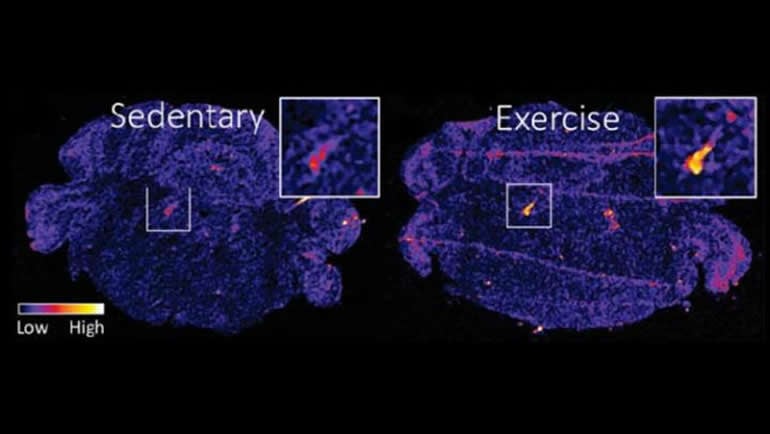Summary: Exercise increases levels of galanin in the brain stem, making mice more resilient to stress.
Source: SfN
Exercise fights off stress by increasing levels of the brain protein galanin, according to research in mice recently published in Journal of Neuroscience.
Going on a run during a stressful time does wonders for mental and emotional health. But the stress-relief benefits of exercise go beyond the anecdotal: exercise increases the brain’s resilience to stress. This happens through elevated levels of the neuromodulator galanin, a protein that influences stress and mood and has been implicated in stress-related psychiatric disorders.
In examining the relationship between exercise and stress relief, Tillage et al. measured anxious behaviors in mice 24 hours after a stressful event. Mice that had access to an exercise wheel for three weeks displayed fewer anxious behaviors compared to mice that didn’t exercise. The exercising mice also had elevated galanin levels in the locus coeruleus, a cluster of neurons in the brainstem involved in the stress response.
The amount of time the mice spent exercising in the third week correlated with the amount of galanin in the locus coeruleus, which in turn correlated with their degree of stress resilience.

Genetically increasing locus coeruleus galanin in sedentary mice recapitulated the beneficial effects of exercise. The increased galanin did not alter other aspects of the animal’s behavior, suggesting galanin may be recruited only during periods of high stress.
About this neurodevelopment research article
Source:
SfN
Contacts:
Calli McMurray – SfN
Image Source:
The image is credited to Tillage et al., JNeurosci 2020.
Original Research: Closed access
“Chronic Environmental or Genetic Elevation of Galanin in Noradrenergic Neurons Confers Stress Resilience in Mice” by Rachel P. Tillage, Genevieve E. Wilson, L. Cameron Liles, Philip V. Holmes and David Weinshenker. Journal of Neuroscience.
Abstract
Chronic Environmental or Genetic Elevation of Galanin in Noradrenergic Neurons Confers Stress Resilience in Mice
The neuropeptide galanin has been implicated in stress-related neuropsychiatric disorders in humans and rodent models. While pharmacological treatments for these disorders are ineffective for many individuals, physical activity is beneficial for stress-related symptoms. Galanin is highly expressed in the noradrenergic system, particularly the locus coeruleus (LC), which is dysregulated in stress-related disorders and activated by exercise. Galanin expression is elevated in the LC by chronic exercise, and blockade of galanin transmission attenuates exercise-induced stress resilience. However, most research on this topic has been done in rats, so it is unclear whether the relationship between exercise and galanin is species-specific. Moreover, use of intracerebroventricular galanin receptor antagonists in prior studies precluded defining a causal role for LC-derived galanin specifically. Therefore, the goals of this study were twofold. First, we investigated whether physical activity (chronic wheel running) increases stress resilience and galanin expression in the LC of male and female mice. Next, we used transgenic mice that overexpress galanin in noradrenergic neurons (Gal OX) to determine how chronically elevated noradrenergic-derived galanin, alone, alters anxiogenic-like responses to stress. We found that three weeks of ad libitum access to a running wheel in their home cage increased galanin mRNA in the LC of mice, which was correlated with and conferred resilience to stress. The effects of exercise were phenocopied by galanin overexpression in noradrenergic neurons, and Gal OX mice were resistant to the anxiogenic effect of optogenetic LC activation. These findings support a role for chronically increased noradrenergic galanin in mediating resilience to stress.
Significance statement
Understanding the neurobiological mechanisms underlying behavioral responses to stress is necessary to improve treatments for stress-related neuropsychiatric disorders. Increased physical activity is associated with stress resilience in humans, but the neurobiological mechanisms underlying this effect are not clear. Here we investigate a potential causal mechanism of this effect driven by the neuropeptide galanin from the main noradrenergic nucleus, the locus coeruleus (LC). We show that chronic voluntary wheel running in mice increases stress resilience and increases galanin expression in the LC. Furthermore, we show that genetic overexpression of galanin in noradrenergic neurons causes resilience to a stressor and the anxiogenic effects of optogenetic LC activation. These findings support a role for chronically increased noradrenergic galanin in mediating resilience to stress.






